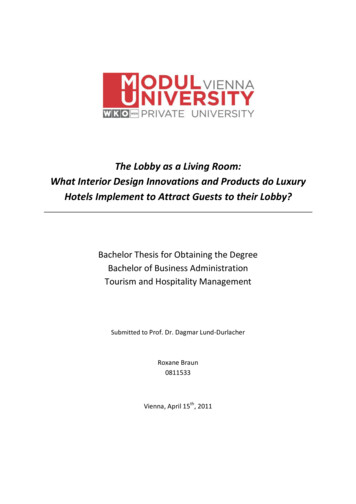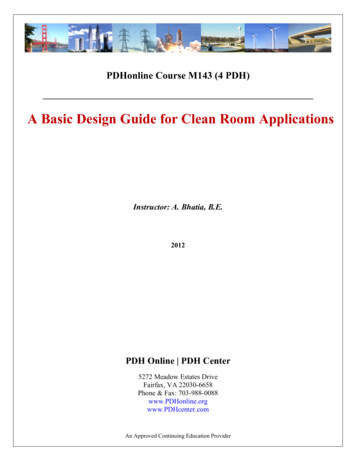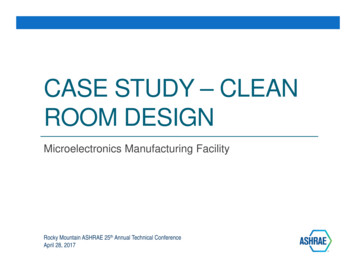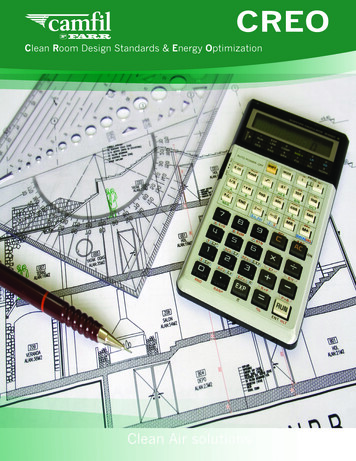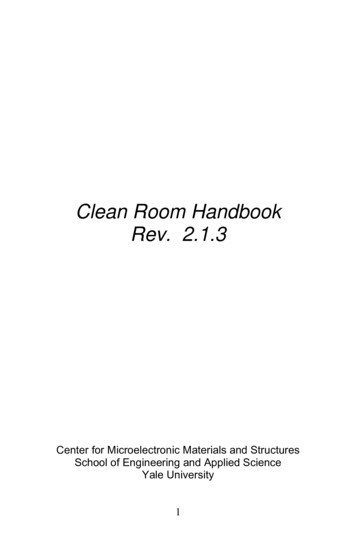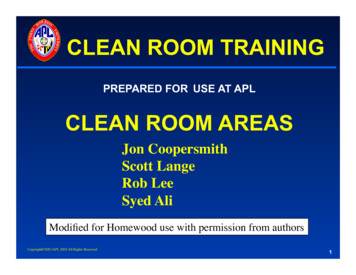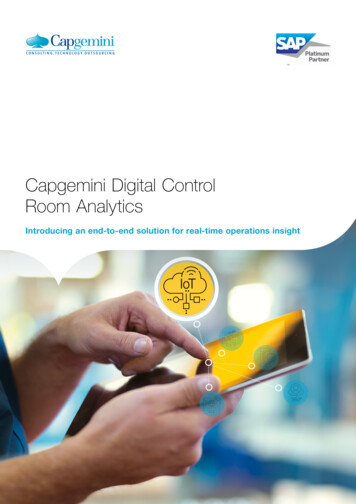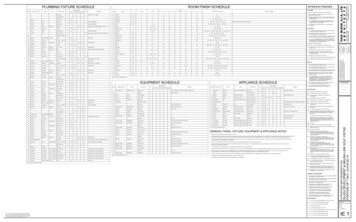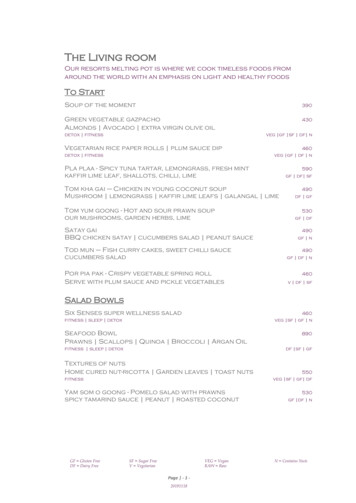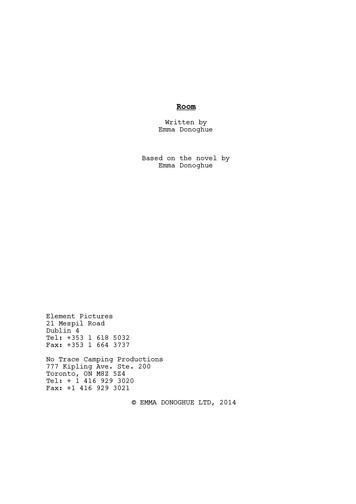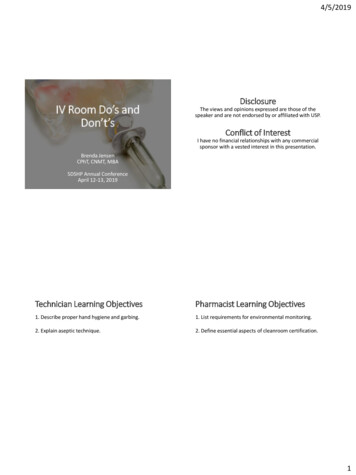
Transcription
4/5/2019IV Room Do’s andDon’t’sDisclosureThe views and opinions expressed are those of thespeaker and are not endorsed by or affiliated with USP.Conflict of InterestI have no financial relationships with any commercialsponsor with a vested interest in this presentation.Brenda JensenCPhT, CNMT, MBASDSHP Annual ConferenceApril 12-13, 2019Technician Learning ObjectivesPharmacist Learning Objectives1. Describe proper hand hygiene and garbing.1. List requirements for environmental monitoring.2. Explain aseptic technique.2. Define essential aspects of cleanroom certification.1
4/5/2019Do 1. Comply with state and federal law, and nationalstandards.2. Comply with accreditation and credentialingstandards (as applicable).2
4/5/2019Do UnderstandDo UnderstandShall or Must – RequirementShould - RecommendationPEC - Primary engineering control is where CSPs arecompounded.Examples: LAFW and CAILAFW – Laminar Airflow WorkbenchCAI – Compounding Aseptic IsolatorCSP – Compounded sterile preparationHD – Hazardous Drug (as defined by NIOSH)BUD – Beyond-use dateAnte-Room – ISO-7 or ISO-8 classified room wherehand hygiene and garbing occur.Do UnderstandC-PEC – Containment primary engineering control iswhere hazardous CSPs are compounded.Examples: BSC and CACI.BSC – Biological Safety CabinetCACI - Compounding Aseptic Containment IsolatorSEC – Secondary engineering control is where PEC islocated.Examples: Positive pressure ISO-7 buffer room orsegregated compounding area (SCA).Do Consider the design of thecleanroom.C-SEC - Containment secondary engineering control iswhere C-PEC is located.Examples: Negative pressure ISO-7 buffer room orcontainment segregated compounding area (C-SCA).3
4/5/2019Do Consider the environmentoutside of the cleanroom.Do Consider the people enteringthe cleanroom.Don’t Enter sterile compoundingareas withDon’t Enter sterile compoundingareas with Outer garments Cosmetics Hand, wrist, visible jewelry andpiercings (e.g., earrings, lipor eyebrow piercings) Nail polish Artificial nailsRashesSunburnWeeping soresConjunctivitisActive respiratory infectionNatural nails shall be kept neat and trimmed.4
4/5/2019Do Don garb dirtiest to cleanestDon’t Forget beard covers. Dedicated shoes or shoe covers on clean side of lineof demarcation. Dirty shoes should never touchclean side. Head and facial hair covers (e.g., beard covers) Face masks Eye shields.Eye shields are optional unless working with irritantssuch as germicidal disinfecting agents or whenpreparing hazardous drugs.Do Perform hand hygiene byDo DonRemoving debris from underneath fingernails using anail cleaner under running warm water followed byvigorous hand washing. Hands and forearms shall bewashed to the elbows for at least 30 seconds with soap(either nonantimicrobial or antimicrobial) and waterwhile in the ante-room. Dry hands and forearms tothe elbows using lint-free disposable towels .A nonshedding gown with sleeves that fit snugly aroundthe wrists and enclosed at the neck.Once inside the buffer room or segregatedcompounding area, and prior to donning sterilepowder-free gloves, antiseptic hand cleansing shall beperformed using a waterless alcohol-based surgicalhand scrub with persistent activity. Hands are allowedto dry thoroughly before donning sterile gloves. Sterilegloves shall be the last item donned beforecompounding begins.5
4/5/2019Do DisinfectDon’t LeaveContaminated gloved hands by wiping or rubbing sterile70% IPA to all contact surface areas of the gloves andletting the gloved hands dry thoroughly.ISO Class 7 area without reperforming hand-hygiene andgarbing before reentering the ISO Class 7 buffer room.Routine application of sterile 70% IPA to sterile glovesshall occur throughout the compounding process andwhenever nonsterile surfaces (e.g. vials, counter tops,chairs, carts) are touched.Don’t ReuseDo Doff garbShoe covers, hair and facial hair covers, face masks/eyeshields, or gloves.On the clean side of line of demarcation in ante-roomor segregated compounding area. Remove gloves and perform hand hygiene. Remove gown and discard it, or hang it on hook if itis to be reused within the same work shift. Remove and discard mask, head/beard cover. Remove and discard shoe covers one at a time,ensuring that uncovered foot is placed on the dirtyside of the line of demarcation and perform handhygiene again.Gown used in non-HD areas may be removed andretained in the ante-room or segregated compoundingarea if not visibly soiled, to be re-donned during thatsame work shift only.6
4/5/2019Do Don additional PPE forhazardous compounding Second set of shoe covers. Chemo gown (may not be re-used)Change per manufacturer or every 2-3 hours or aftersplash/spill Two pairs of chemotherapy gloves.Change per manufacturer or every 30 minutes or aftertear. Remove and discard outer glove while in BSC orCACI.Do KnowLAFW – Laminar Airflow Workbench (PEC)Protects the product or preparation. No personnelprotection.May be either horizontal or vertical air flow. BSC – Biological Safety Cabinet (C-PEC)Protects personnel. Used for hazardous drugs.Vertical air flow.Class II Type A2, B1, or B2Class IIIBest to run PEC (LAFW) continuously. C-PEC (BSC) mustrun continuously (per 800 ). LAFW/BSC must run 30minutes before use after being off.Do KnowDO Clean and disinfect the PECRABS – Restricted Access Barrier System CAI – Compounding Aseptic Isolator (PEC)Protects the product or preparation. No personnelprotection.Vertical air flow, positive pressure. CACI – Compounding Aseptic Containment Isolator(C-PEC)Protects personnel. Used for hazardous drugs.Vertical air flow, negative pressure.IsolatorContains an internal system to decontaminateinterior with sporicidal agent.At the beginning of each shift, before each batch, notlonger than 30 minutes following the previous surfacedisinfection when ongoing compounding activities areoccurring, after spills, and when surface contaminationis known or suspected.Remove items from areas to be cleaned, and cleansurfaces by removing loose material and residue fromspills; e.g., remove water-soluble residues with sterilewater (for injection or irrigation) using low sheddingwipes then wipe with a residue-free disinfecting agentsuch as sterile 70% IPA, and allow to dry beforecompounding begins.7
4/5/2019Do Clean and disinfect PECFrom cleanest to dirtiest using overlapping strokes anda new side of the cloth for each location. Start bycarefully cleaning the grid covering the HEPA filter.LAFW (horizontal air flow)Clean top then sides then work surface.BSC and LAFW (vertical air flow)Clean back then then work surface.CAI and CACI with the front panel closed:Follow manufacturer’s instructions or if not stated startwith the work chamber then move to the antechamber. Start by carefully cleaning the grid coveringthe HEPA filter being careful not to let any liquid enter.Clean back wall, sides, front wall and work surface.Clean the gauntlet sleeves. Apply sterile gloves overgauntlet gloves. Sanitize gloves frequently with sterile70% isopropyl alcohol.CAI with the front panel open:Follow manufacturer’s instructions or if not stated openfront panel and start with the work chamber then moveto the ante chamber. Start by carefully cleaning the gridcovering the HEPA filter being careful not to let anyliquid enter. Clean back wall, sides, areas under thework surface (if applicable), work surface, and front wall.Do Follow manufacturer’srecommendationsClean the gauntlet sleeves. Apply sterile gloves overgauntlet gloves. Sanitize gloves frequently with sterile70% isopropyl alcohol.Know purge time before moving items from antechamber to work chamber.For changing gauntlet sleeves and gauntlet gloves.Know recovery time to return to ISO 5 after CAI isturned off. CACI should never be turned off.Reminder: do not open the front panel on CACI.8
4/5/2019Do Use a sporicidal agentOn ISO-5 surfaces (including under the work surface) atleast monthly. Document cleaning and disinfectingagents (and contact time as applicable).Do UnderstandDeactivation renders a compound inactive. If nospecific information is available on SDS then use sodiumhypochlorite or other EPA registered oxidizer.Decontamination removes inactivated substances. Mayuse sodium hypochlorite, peroxide, 70% IPA, or water.Do Deactivate, decontaminate,clean, and disinfectC-PEC at least daily and area under the work surface atleast monthly.Decontaminate, clean, and disinfect betweencompounding of different HDs, any time a spill occurs,before and after certification, any time voluntaryinterruption occurs, and if moved.Document agents used and contact times.Do Clean and disinfectAnte-Room and Buffer Room andSegregated Compounding AreaWork surfaces at least daily.Floors daily at a time when no aseptic operations are inprogress.Use mop labeled ‘floor’ start at area furthest from door(cleanest) moving to door (dirtiest). Buffer room firstthen ante-room. Floor mops may be used in both thebuffer room and ante-room, but only in that order.9
4/5/2019Do Clean and disinfectDo PerformCeiling, walls, carts, equipment exteriors storage andanything not covered in daily cleaning monthly.Ceiling first then walls, area furthest from door(cleanest) moving to door (dirtiest). Buffer room firstthen ante-room. Clean and disinfect equipmentexteriors, storage and any other areas not covered indaily cleaning/disinfection. Must be done all in one daywhen no aseptic operations are in progress.Monthly cleaning any time the clean room iscompromised including Inappropriate garbing or staging When HEPA fans are off (for any reason includingmaintenance and power outages) Walls/ceiling have been openedDocument date, time, cleaning agent, disinfectant andcontact time. Use sporicidal agent on all surfaces atleast monthly.Do Understand additionalrequirements for C-SEC (per 800 ).Do Perform and documentenvironmental monitoring.All areas where hazardous drugs are handled and allreusable equipment and devices must be deactivated,decontaminated, cleaned and disinfected.Daily Temperature ( or equal to 77F ideally 68F) Humidity (recommend 60%) PressuresPositive (non-HD rooms) at least 0.02Negative (HD rooms) -0.01 to -0.03 Refrigerator/Freezer temperaturesRefrigerators 2 to 8C (36 to 46F)Freezers -25 to -10C (-13 to 14F)It is incumbent on compounding personnel to ensurethat such cleaning is performed properly. Schedules ofuse and methods of application shall be in accordancewith written SOPs and followed by custodial orcompounding personnel.10
4/5/2019Each day of use Incubator temperature and checking of contentsPeriodic Surface testing in all ISO-classified and segregatedcompounding areas. Use TSA with lecithin and polysorbate 80.Incubate 30-35C for 48 to 72 hours. Recommended action levelsISO 5 3 cfuISO 7 5 cfuISO 8 100 cfuEvery 6 months Nonviable air counts under dynamic conditions. Viable air counts (400-1000L volumetric air sample)using TSA (and MEA for high-risk) under dynamicconditions with growth identified/reported as CFUper cubic meter. Recommended action levelsISO 5 1 cfuISO 7 10 cfuISO 8 100 cfu ACPH Pressure HEPA IntegrityDo IdentifyDo Immediately remediateAny microbial bioburden captured as a cfu using animpaction air sampler to at least the genus level.Using an appropriate credentialed laboratory.Highly pathogenic microorganisms (e.g., Gramnegative rods, coagulase positive staphylococcus,molds and yeasts) with the assistance of a competentmicrobiologist, infection control professional, orindustrial hygienist.Regardless of the number of cfu further correctiveactions will be dictated by the identification ofmicroorganisms.11
4/5/2019Do Re-evaluateDo Ensure equipment isAdequacy of personnel work practices, cleaningprocedures, operational procedures, and air filtrationefficiency within the aseptic compounding location ifany cfu count exceeds its respective action level Clean Used appropriately Properly maintained, verified, calibrated, certified.An investigation into the source of the contaminationshall be conducted. Sources could include HVACsystems, damaged HEPA filters, and changes inpersonnel garbing or working practices. The source ofthe problem shall be eliminated, the affected areacleaned, and resampling performed. Do Stage equipment and suppliesDo OpenBy first removing from shipping cartons. No shipping orother external cartons may be taken into the bufferroom or segregated compounding area (or C-SCA).Sealed sterile pouches as the supplies are introducedinto the ISO Class 5 PEC without disinfecting theindividual items.HoodBalanceRepeater pumpCompounderStage equipment and supplies by wiping with sterile70% IPA and a low lint wipe before entering bufferroom and again into PEC.12
4/5/2019Aseptic Technique Do’s and Don’t’s Do Ensure first air touches critical points of vials,syringes, needles, etc. Don’t shadow.Hands/objects should never comebetween critical point andHEPA filter. Don’t touch critical points orallow critical points to touchnonsterile surfaces.Where’s the first air?LAFWDCA 6 inches from frontabove work surfaceCritical PointsVialStoppersSyringesTip, Piston Plunger, Inner ShaftNeedlesHub, Bevel, Tip, Heel, Shaft, LumenTaking apart vials or syringes adds risk.Aseptic Technique Do’s and Don’t’sBSCDCA 4 inches Do work in the direct compounding area (DCA).Do keep trash out of direct compounding area (DCA).Don’t rest hands/arms on DCA.Don’t allow head to enter PEC.Do disinfect gloves every time they leave the PEC.Do use slow purposeful movements.Don’t sneeze, cough, or talk excessively.Do compound one preparation or batch at a time.13
4/5/2019Do DisinfectDo Understand HD requirementsVials, injection ports, etc. by wiping with sterile 70% IPAswabs and allowing to dry. Wipe down HD containers to reduce the amount ofcontamination introduced into the C-PEC. Supplemental engineering controls [CSTD] should beused w
whenever nonsterile surfaces (e.g. vials, counter tops, chairs, carts) are touched. Don’t Leave ISO Class 7 area without reperforming hand-hygiene and garbing before reentering the ISO Class 7 buffer room. Don’t Reuse Shoe covers, hair and facial hair covers, face masks/eye shields, or gloves. Gown used in non-HD areas may be removed and
